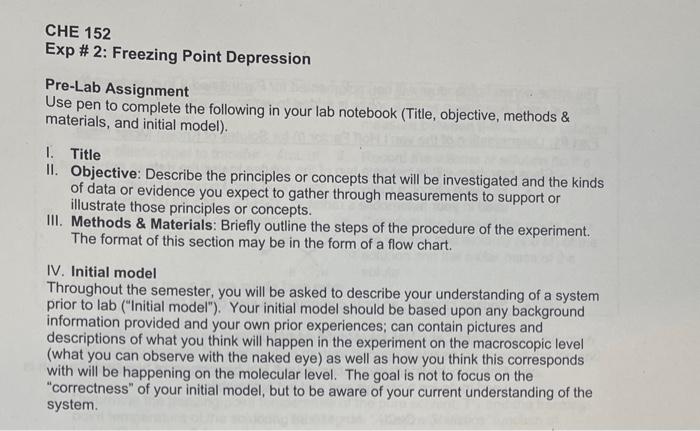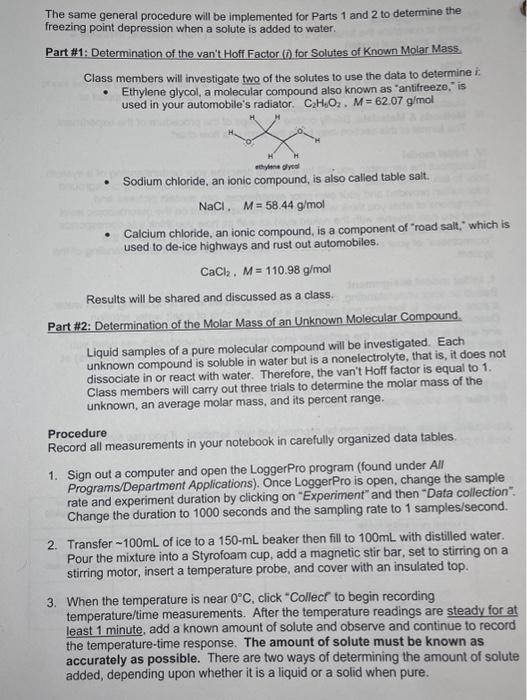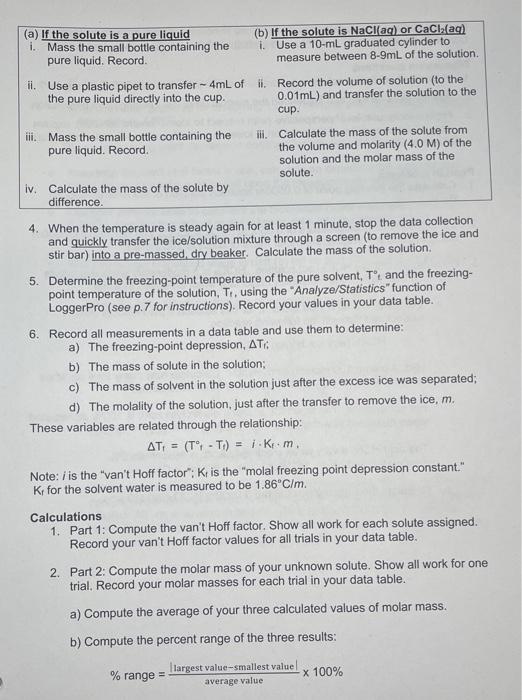Answered step by step
Verified Expert Solution
Question
1 Approved Answer
please answer the following Exp # 2: Freezing Point Depression Pre-Lab Assignment Use pen to complete the following in your lab notebook (Title, objective, methods
please answer the following 


Exp \# 2: Freezing Point Depression Pre-Lab Assignment Use pen to complete the following in your lab notebook (Title, objective, methods \& materials, and initial model). I. Title II. Objective: Describe the principles or concepts that will be investigated and the kinds of data or evidence you expect to gather through measurements to support or illustrate those principles or concepts. III. Methods \& Materials: Briefly outline the steps of the procedure of the experiment. The format of this section may be in the form of a flow chart. IV. Initial model Throughout the semester, you will be asked to describe your understanding of a system prior to lab ("Initial model"). Your initial model should be based upon any background information provided and your own prior experiences; can contain pictures and descriptions of what you think will happen in the experiment on the macroscopic level (what you can observe with the naked eye) as well as how you think this corresponds with will be happening on the molecular level. The goal is not to focus on the "correctness" of your initial model, but to be aware of your current understanding of the system. The same general procedure will be implemented for Parts 1 and 2 to determine the freezing point depression when a solute is added to water. Part \#1: Determination of the van't Hoff Factor (i) for Solutes of Known Molar Mass. Class members will investigate two of the solutes to use the data to determine i : - Ethylene glycol, a molecular compound also known as "antifreeze," is used in your automobile's radiator. C2H1O2,M=62.07g/mol - Sodium chloride, an ionic compound, is also called table salt. NaCl. M=58.44g/mol - Calcium chloride, an ionic compound, is a component of "road salt," which is used to de-ice highways and rust out automobiles. CaCl.M=110.98g/mol Results will be shared and discussed as a class. Part \#2: Determination of the Molar Mass of an Unknown Molecular Compound. Liquid samples of a pure molecular compound will be investigated. Each unknown compound is soluble in water but is a nonelectrolyte, that is, it does not dissociate in or react with water. Therefore, the van't Hoff factor is equal to 1. Class members will carry out three trials to determine the molar mass of the unknown, an average molar mass, and its percent range. Procedure Record all measurements in your notebook in carefully organized data tables: 1. Sign out a computer and open the LoggerPro program (found under All Programs/Department Applications). Once LoggerPro is open, change the sample rate and experiment duration by clicking on "Experiment" and then "Data collection". Change the duration to 1000 seconds and the sampling rate to 1 samples/second. 2. Transfer 100mL of ice to a 150mL beaker then fill to 100mL with distilled water. Pour the mixture into a Styrofoam cup, add a magnetic stir bar, set to stirring on a stirring motor, insert a temperature probe, and cover with an insulated top. 3. When the temperature is near 0C, click "Collect to begin recording temperature/time measurements. After the temperature readings are steady for at least 1 minute, add a known amount of solute and observe and continue to record the temperature-time response. The amount of solute must be known as accurately as possible. There are two ways of determining the amount of solute added, depending upon whether it is a liquid or a solid when pure. (a) If the solute is a pure liquid (b) If the solute is NaCl(aq) or CaCl2(aq) i. Mass the small bottle containing the i. Use a 10-mL graduated cylinder to pure liquid. Record. measure between 8.9mL of the solution. ii. Use a plastic pipet to transfer 4mL of ii. Record the volume of solution (to the the pure liquid directly into the cup. 0.01mL ) and transfer the solution to the cup. iii. Mass the small bottle containing the iii. Calculate the mass of the solute from pure liquid. Record. the volume and molarity (4.0M) of the solution and the molar mass of the solute. iv. Calculate the mass of the solute by difference. 4. When the temperature is steady again for at least 1 minute, stop the data collection and quickly transfer the ice/solution mixture through a screen (to remove the ice and stir bar) into a pre-massed, dry beaker. Calculate the mass of the solution. 5. Determine the freezing-point temperature of the pure solvent, Tt and the freezingpoint temperature of the solution, T1, using the "Analyze/Statistics" function of LoggerPro (see p.7 for instructions). Record your values in your data table. 6. Record all measurements in a data table and use them to determine: a) The freezing-point depression, Ti. b) The mass of solute in the solution; c) The mass of solvent in the solution just after the excess ice was separated; d) The molality of the solution, just after the transfer to remove the ice, m. These variables are related through the relationship: Ti=(TioT1)=iKfm. Note: i is the "van't Hoff factor"; Kr is the "molal freezing point depression constant." Kt for the solvent water is measured to be 1.86C/m. Calculations 1. Part 1: Compute the van't Hoff factor. Show all work for each solute assigned. Record your van't Hoff factor values for all trials in your data table. 2. Part 2: Compute the molar mass of your unknown solute. Show all work for one trial. Record your molar masses for each trial in your data table. a) Compute the average of your three calculated values of molar mass. b) Compute the percent range of the three results: %range=averagevaluelargestvaluesmallestvaluel100% Exp \# 2: Freezing Point Depression Pre-Lab Assignment Use pen to complete the following in your lab notebook (Title, objective, methods \& materials, and initial model). I. Title II. Objective: Describe the principles or concepts that will be investigated and the kinds of data or evidence you expect to gather through measurements to support or illustrate those principles or concepts. III. Methods \& Materials: Briefly outline the steps of the procedure of the experiment. The format of this section may be in the form of a flow chart. IV. Initial model Throughout the semester, you will be asked to describe your understanding of a system prior to lab ("Initial model"). Your initial model should be based upon any background information provided and your own prior experiences; can contain pictures and descriptions of what you think will happen in the experiment on the macroscopic level (what you can observe with the naked eye) as well as how you think this corresponds with will be happening on the molecular level. The goal is not to focus on the "correctness" of your initial model, but to be aware of your current understanding of the system. The same general procedure will be implemented for Parts 1 and 2 to determine the freezing point depression when a solute is added to water. Part \#1: Determination of the van't Hoff Factor (i) for Solutes of Known Molar Mass. Class members will investigate two of the solutes to use the data to determine i : - Ethylene glycol, a molecular compound also known as "antifreeze," is used in your automobile's radiator. C2H1O2,M=62.07g/mol - Sodium chloride, an ionic compound, is also called table salt. NaCl. M=58.44g/mol - Calcium chloride, an ionic compound, is a component of "road salt," which is used to de-ice highways and rust out automobiles. CaCl.M=110.98g/mol Results will be shared and discussed as a class. Part \#2: Determination of the Molar Mass of an Unknown Molecular Compound. Liquid samples of a pure molecular compound will be investigated. Each unknown compound is soluble in water but is a nonelectrolyte, that is, it does not dissociate in or react with water. Therefore, the van't Hoff factor is equal to 1. Class members will carry out three trials to determine the molar mass of the unknown, an average molar mass, and its percent range. Procedure Record all measurements in your notebook in carefully organized data tables: 1. Sign out a computer and open the LoggerPro program (found under All Programs/Department Applications). Once LoggerPro is open, change the sample rate and experiment duration by clicking on "Experiment" and then "Data collection". Change the duration to 1000 seconds and the sampling rate to 1 samples/second. 2. Transfer 100mL of ice to a 150mL beaker then fill to 100mL with distilled water. Pour the mixture into a Styrofoam cup, add a magnetic stir bar, set to stirring on a stirring motor, insert a temperature probe, and cover with an insulated top. 3. When the temperature is near 0C, click "Collect to begin recording temperature/time measurements. After the temperature readings are steady for at least 1 minute, add a known amount of solute and observe and continue to record the temperature-time response. The amount of solute must be known as accurately as possible. There are two ways of determining the amount of solute added, depending upon whether it is a liquid or a solid when pure. (a) If the solute is a pure liquid (b) If the solute is NaCl(aq) or CaCl2(aq) i. Mass the small bottle containing the i. Use a 10-mL graduated cylinder to pure liquid. Record. measure between 8.9mL of the solution. ii. Use a plastic pipet to transfer 4mL of ii. Record the volume of solution (to the the pure liquid directly into the cup. 0.01mL ) and transfer the solution to the cup. iii. Mass the small bottle containing the iii. Calculate the mass of the solute from pure liquid. Record. the volume and molarity (4.0M) of the solution and the molar mass of the solute. iv. Calculate the mass of the solute by difference. 4. When the temperature is steady again for at least 1 minute, stop the data collection and quickly transfer the ice/solution mixture through a screen (to remove the ice and stir bar) into a pre-massed, dry beaker. Calculate the mass of the solution. 5. Determine the freezing-point temperature of the pure solvent, Tt and the freezingpoint temperature of the solution, T1, using the "Analyze/Statistics" function of LoggerPro (see p.7 for instructions). Record your values in your data table. 6. Record all measurements in a data table and use them to determine: a) The freezing-point depression, Ti. b) The mass of solute in the solution; c) The mass of solvent in the solution just after the excess ice was separated; d) The molality of the solution, just after the transfer to remove the ice, m. These variables are related through the relationship: Ti=(TioT1)=iKfm. Note: i is the "van't Hoff factor"; Kr is the "molal freezing point depression constant." Kt for the solvent water is measured to be 1.86C/m. Calculations 1. Part 1: Compute the van't Hoff factor. Show all work for each solute assigned. Record your van't Hoff factor values for all trials in your data table. 2. Part 2: Compute the molar mass of your unknown solute. Show all work for one trial. Record your molar masses for each trial in your data table. a) Compute the average of your three calculated values of molar mass. b) Compute the percent range of the three results: %range=averagevaluelargestvaluesmallestvaluel100% 


Step by Step Solution
There are 3 Steps involved in it
Step: 1

Get Instant Access to Expert-Tailored Solutions
See step-by-step solutions with expert insights and AI powered tools for academic success
Step: 2

Step: 3

Ace Your Homework with AI
Get the answers you need in no time with our AI-driven, step-by-step assistance
Get Started


